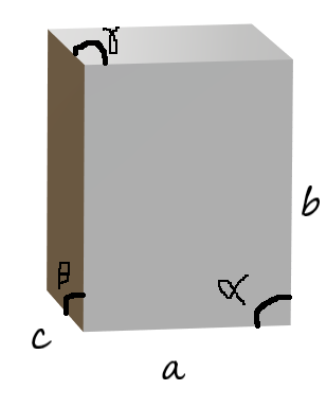
In the tetragonal crystal system, which of the following is true?
A. All axial lengths and all axial angles are equal
B. All three axial lengths are equal
C. All three axial angles are equal
D. Two axial angles are equal but the third is different
Answer
570.3k+ views
Hint: Here, we have to have the knowledge about crystal systems and their structures. Knowing the structures we can know whether the angles and lengths are equal or not. Crystallography is the study of crystals systems and lattice systems.
Complete step by step answer:
Here, it is important that we discuss the tetragonal crystal system in detail. Let’s first start with talking about crystallography and crystal systems.
In crystallography, the Crystal system, crystal family and lattice system refers to several classes of space groups, lattices, point groups and crystals. They are commonly confused with each other but are slightly different from each other. There are seven crystal systems which are Isometric. Tetragonal, Orthorhombic, Hexagonal, Triclinic, Monoclinic and Rhombohedral crystal systems.
Tetragonal crystal system is one of the seven crystal systems. Tetragonal Crystal lattices are formed as a result of stretching a cubic lattice along one of its lattice vectors. So, a cube becomes a rectangular prism with a square base. Examples of tetragonal crystal properties include apophyllite, zircon, rutile quartz and scheelite.
The structure of Tetragonal crystal system is as given below:

The sides a, b and c are called the axial lengths. The sides a and c are equal in length. But length b is different in length. That is
\[a = b \ne c\]
The angles alpha, beta and gamma are called the axial angles. The angle between sides a and b is called alpha ( \[\alpha \] ). The angle between sides b and c is called beta ( \[\beta \] ) and the angle between sides a and c is called gamma ( \[\gamma \] ). All the three angles are of the same degree. Therefore, as we see the options we can see that three options are true and one is incorrect. Option C is correct and the other three are incorrect.
Therefore, our answer is option C.
Note:
One should know the structures of every compound or crystal system to get the answers of every structural related question of any compound.
Complete step by step answer:
Here, it is important that we discuss the tetragonal crystal system in detail. Let’s first start with talking about crystallography and crystal systems.
In crystallography, the Crystal system, crystal family and lattice system refers to several classes of space groups, lattices, point groups and crystals. They are commonly confused with each other but are slightly different from each other. There are seven crystal systems which are Isometric. Tetragonal, Orthorhombic, Hexagonal, Triclinic, Monoclinic and Rhombohedral crystal systems.
Tetragonal crystal system is one of the seven crystal systems. Tetragonal Crystal lattices are formed as a result of stretching a cubic lattice along one of its lattice vectors. So, a cube becomes a rectangular prism with a square base. Examples of tetragonal crystal properties include apophyllite, zircon, rutile quartz and scheelite.
The structure of Tetragonal crystal system is as given below:

The sides a, b and c are called the axial lengths. The sides a and c are equal in length. But length b is different in length. That is
\[a = b \ne c\]
The angles alpha, beta and gamma are called the axial angles. The angle between sides a and b is called alpha ( \[\alpha \] ). The angle between sides b and c is called beta ( \[\beta \] ) and the angle between sides a and c is called gamma ( \[\gamma \] ). All the three angles are of the same degree. Therefore, as we see the options we can see that three options are true and one is incorrect. Option C is correct and the other three are incorrect.
Therefore, our answer is option C.
Note:
One should know the structures of every compound or crystal system to get the answers of every structural related question of any compound.
Recently Updated Pages
A man running at a speed 5 ms is viewed in the side class 12 physics CBSE

State and explain Hardy Weinbergs Principle class 12 biology CBSE

Which of the following statements is wrong a Amnion class 12 biology CBSE

Two Planoconcave lenses 1 and 2 of glass of refractive class 12 physics CBSE

The compound 2 methyl 2 butene on reaction with NaIO4 class 12 chemistry CBSE

Bacterial cell wall is made up of A Cellulose B Hemicellulose class 12 biology CBSE

Trending doubts
What are the major means of transport Explain each class 12 social science CBSE

Which are the Top 10 Largest Countries of the World?

Draw a labelled sketch of the human eye class 12 physics CBSE

Explain sex determination in humans with line diag class 12 biology CBSE

Give 10 examples of unisexual and bisexual flowers

State the principle of an ac generator and explain class 12 physics CBSE




